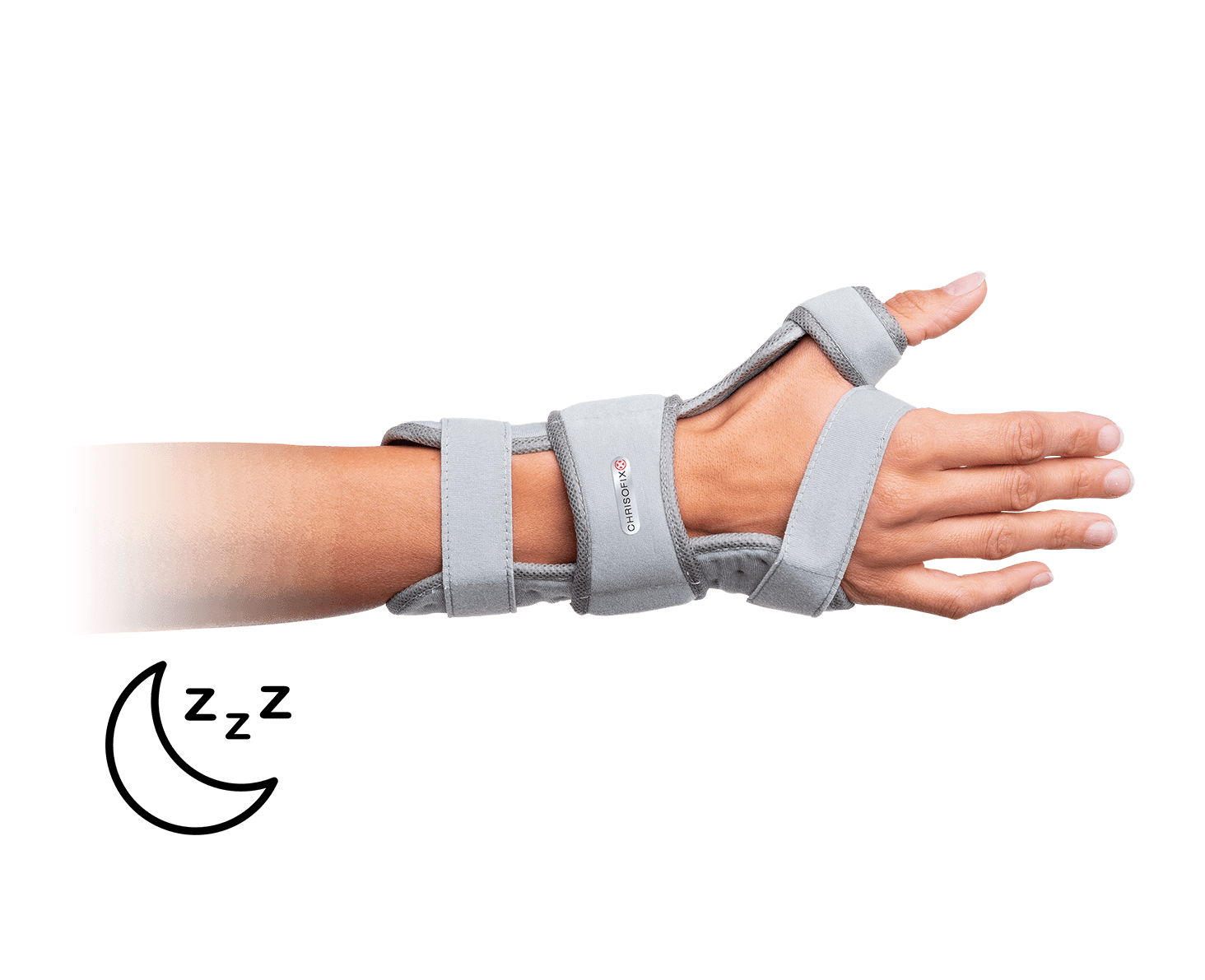CHRISOFIX®
Saddle joint orthoses for osteoarthritis
/rhizarthrosis/De Quervain’s syndrome
World-class Orthoses
Developed and Patented
in Switzerland 
Do you have saddle joint complaints?
What is saddle joint arthritis?
Stress and strain, the use of computers and other electronic devices, housework, sporting activities and previous injuries may all play a role in the development of rhizarthrosis.
Saddle joint arthritis is characterized by typical symptoms. It is important to recognize these symptoms in time and to take them seriously in order to retain pain free and adequate function of our hand.
Who is most often affected by saddle joint arthritis (rhizarthrosis)?
Saddle joint arthritis is three to four times more common in women then it is in men. The process of joint degeneration may start around the age of 40, but most typically it becomes symptomatic over the age of 50.
What are the most common symptoms of saddle joint arthritis (rhizarthrosis)?
The most common symptom accompanying saddle joint arthritis (arthritis of the I. carpometacarpal joint) is sharp pain provoked by strong grasping or pinching (writing, lifting a cup, turning a key, opening a bottle etc). Another characteristic of saddle joint arthritis is that certain typical motions or movements provoke the pain (i.e. twisting motion, unscrewing a cap, extending or stretching the thumb). Initially the pain is only associated to motion however, later on it may occur during rest or even during the night. Symptom free periods may alternate with periods of variable length characterized by pain and complaints due to symptoms. Another typical symptom is that due to the degeneration of the cartilage the joint is deformed, and the bones that make up the saddle joint may protuberate or “bulge out”.
What is De Quervain’s syndrome?
Sharp pain, provoked by certain movements of the thumb may draw attention to De Quervain’s syndrome. The ligamentous tunnel located near the base of the thumb contains the tendons that extend lift the thumb. Over time wear and tear, repetitive motions of the thumb and wrist (i.e. repetitive lifting of heavy objects or a
beloved child) lead to the narrowing or the development of a “stricture” in this ligamentous tunnel surrounding the tendons. This painful state is called De Quervain’s disease. Stress and strain, the use of computers and other electronic devices, housework, sporting activities and previous injuries may all play a role in the development of De Quervain’s syndrome. De Quervain’s Syndrome is characterized by typical symptoms. It is important to recognize these symptoms in time and to take them seriously in order to retain pain free and adequate function
of our hand.
Who is most often affected by De Quervain’s syndrome?
De Quervain’syndrome is more common in women than it is in men. De Quervain’s syndrome may start around ages as young as 40, but most typically it becomes symptomatic around the age of 30-50. Often those caring for small children especially a newborn are affected by DeQuervain’s disease. Office work, or work involving fine but repetitive thumb motions and heavy physical labour may also lead to the development of this disease.
What are the most common symptoms of De Quervain’s syndrome?
The most common symptom accompanying De Quervain’s syndrome is sharp pain provoked by flexing/extending the thumb, or “sideway” motions of the wrist, strong grasping or pinching (writing, lifting a cup, turning a key, opening a bottle etc).
Another characteristic of De Quervain’s syndrome is that certain typical motions or movements provoke the pain (i.e. twisting motion, unscrewing a cap, extending or stretching the thumb). Initially the pain is only associated with motion however, later on it may occur during rest or even during the night. Symptom free periods may alternate with periods of variable length characterised by pain and complaints due to symptoms. It is also typical that the dull constant ache turns into a sharp pain provoked by the above described motions making everyday tasks or work difficult, even impossible in certain cases
What can we do? How do Chrisofix® saddle joint ortheses help alleviate the problem?
The use of an adequate orthesis that keeps the painful joint in the appropriate position plays a great role in the conservative (meaning without operation) treatment of saddle joint arthritis. By wearing an adequate orthesis the bothersome or even painful symptoms occurring during the day and maybe even during the night maybe alleviated.
How long should we wear the orthesis?
Depending on the severity of the saddle joint arthritis and the symptoms themselves wearing the orthosis may be necessary for a few weeks but more commonly for a few months, therefore comfort stability and hygienic considerations are paramount.
Why Chrisofix® saddle joint ortheses?
In the conservative treatment of saddle joint arthritis (meaning without an operation) resting the painful and degenerated joint in the appropriate position is paramount.
Due to the protuberation – or bulging out – of the bones making up the saddle joint caused by rhizarthrosis, wearing rigid non-malleable orthoses may lead to problems due to imprecise fitting. Thanks to the special innovative design of Chrisofix® saddle joint ortheses the aluminum core that makes up the frame of the orthesis provides adequate stability while maintaining the opportunity for precise and exact fitting. This is especially important in case of saddle joint arthritis as it is often accompanied by the above mentioned deformity. If the orthesis does not fit exactly then pressure symptoms such as pain and skin irritation may occur at the sight of the deformity. The innovative design of Chrisofix® saddle joint ortheses ensure exact and precise fitting thereby preventing unwanted and uncomfortable potential symptoms caused by ill-fitting orthoses (pain caused by pressure and symptoms of skin irritation).
Saddle joint orthosis – Night use
![]()
For night and rest use ![]()
Adequate nighttime splinting is one of the most important keystones in the nonoperative treatment of saddle joint arthritis.
The night use Chrisofix® saddle joint orthosis ensures this adequate positioning while providing excellent stability, comfort and the possibility of exact and precise fitting even in case of a severely deformed saddle joint. the Liner inside the orthosis is both changeable and washable it therefore provides the appropriate comfort and hygiene for the duration of treatment.


FLEXIBLE

LIGHT

PERFORATED

TRANSPARENT

WASHABLE
Contact
Us
+41 52 670 11 60
hello@chrisofix.com
Copyright© CHRISOFIX®
THE FLEXI-FIX HEALER
World-class Orthoses Developed and Patented in Switzerland ![]()
Patent Numbers: 20130035621, 701845B
We are member of Swiss Medtech

Chrisofix Hungary Kft.
Grassalkovich út 272-274.
1239 Budapest,
Hungary
Tel.: +36 1 287 10 56
office@chrisofix.com
Chrisofix AG
Püntenstrasse 35
8185 Winkel, Switzerland
Switzerland
Tel.: +41 52 670 11 60
hello@chrisofix.com
